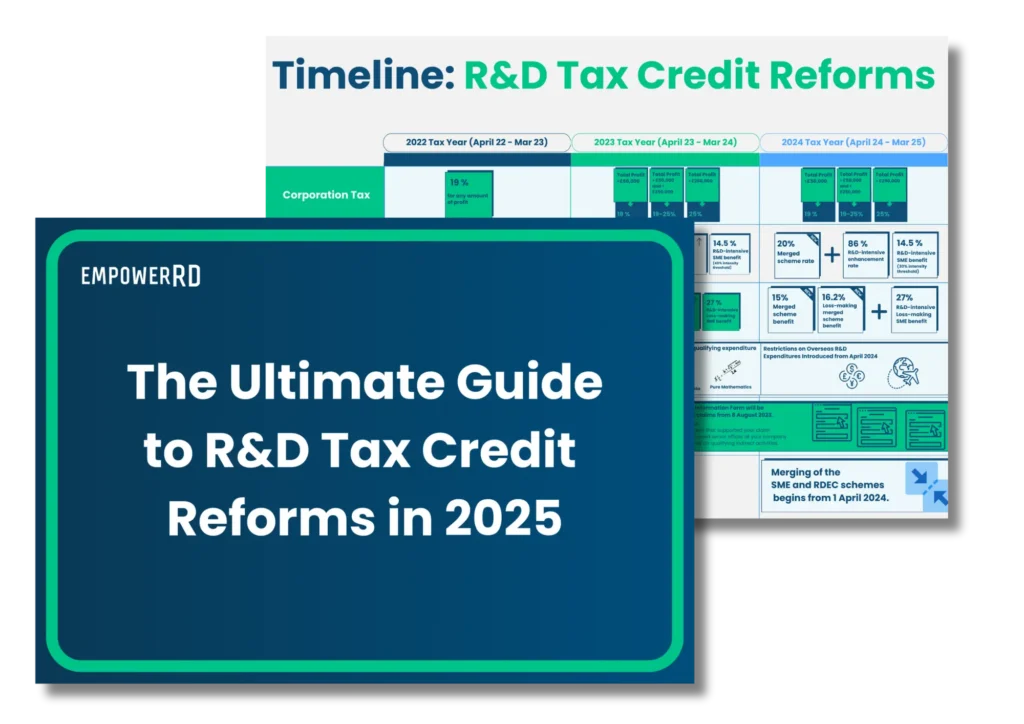In a time where AI and Machine Learning are unlocking new horizons in business, it is crucial for companies to grasp the importance of understanding if their innovations are eligible for R&D tax credits.
This article aims to shed light on the qualifying criteria established by HMRC, helping you assess if your innovation aligns with these requirements. Whether you’re exploring emerging technologies or using established ones, these insights will serve as a compass for evaluating your R&D projects.
Innovation in the context of R&D
Innovation in R&D, a key factor for R&D tax relief:
- encompasses significant advancements in science and technology
- It entails projects that aim to address specific uncertainties in these fields,
- often requiring the expertise of skilled professionals
This type of innovation goes beyond mere novelty; it strives to make meaningful contributions to the respective domains. For instance, software engineers developing innovative data security algorithms, biotechnologists creating novel drug formulations, or mechanical engineers designing engines that reduce emissions all exemplify this spirit of innovation.
Eligibility criteria for R&D Tax Credits
As an R&D tax specialist, we apply the following four criteria to get an initial indication of whether a project could qualify as R&D or not.
- New or improved product: R&D often involves creating or enhancing products, tools, or services, especially when overcoming complex challenges.
- Scientific or technological advance: An R&D project should contribute to scientific or technological advances, ranging from bespoke solutions to significant modifications of existing technologies.
- Scientific or technological challenge: Eligible projects typically encounter scientific or technological uncertainties that aren’t easily resolved, indicating a genuine need for R&D.
- Requiring competent professionals: The involvement of skilled professionals, such as engineers or scientists, is essential, signifying the project’s complexity and innovative nature.
To better understand the qualifying criteria and the types of costs that qualify, read our introduction to R&D tax credits.
Applying criteria to AI and Machine Learning projects
Understanding eligibility for R&D tax credits can be challenging, especially in complex fields like AI and Machine Learning. To clarify the criteria, we’ll showcase two qualifying projects and two non-qualifying examples. We hope this will help you assess your project’s potential for tax relief in real-world scenarios.
Qualifying R&D project using AI technology
Project Name: “GenAI Navigation System for Autonomous Vehicles”
Description:
This project involves developing an advanced navigation system for autonomous vehicles using General AI. The project seeks to create a new product that significantly improves upon existing navigation technologies. The core challenge is to develop a system that can understand and adapt to complex, real-world environments in real-time, something beyond the capabilities of current AI systems.
How it meets the criteria:
- New or improved product: The navigation system substantially improves over existing technologies, providing more accurate and adaptable navigation.
- Scientific or technological advance: The project involves creating a bespoke AI solution that can process and react to unpredictable variables, representing an advance in AI technology.
- Scientific or technological challenge: Overcoming the limitation of current AI in understanding dynamic and unpredictable environments is a significant technological challenge.
- Requiring competent professionals: The project is led by a team of AI researchers, data scientists, and software engineers, highlighting the need for highly skilled professionals.
Non-qualifying R&D project using AI technology
Project Name: “AI-based email sorting system”
Description:
This project involves developing an AI system to sort and categorise emails based on content and sender. The AI technology used is primarily based on existing algorithms and models.
Why it doesn’t meet the criteria:
- New or Improved Product: The system does not significantly improve upon existing email sorting technologies.
- Scientific or Technological Advance: The project utilises off-the-shelf AI technologies without any novel advancement.
- Scientific or Technological Challenge: The solution uses readily available AI techniques and does not encounter significant scientific or technological uncertainties.
- Requiring Competent Professionals: While skilled professionals are involved, the project does not necessarily require advanced AI expertise, indicating a lack of complexity.
Qualifying R&D project using Machine Learning
Project Name: “ML-Driven predictive maintenance for industrial machinery”
Description:
This project aims to develop a machine learning-based predictive maintenance system for industrial machinery. The system will use advanced ML algorithms to predict machine failures before they occur, drastically reducing downtime.
How it meets the criteria:
- New or Improved Product: The predictive maintenance system represents a significant improvement in industrial maintenance techniques.
- Scientific or Technological Advance: Developing ML algorithms capable of accurately predicting machine failures from vast and varied data sets is a substantial technological advance.
- Scientific or Technological Challenge: The challenge lies in creating algorithms that can accurately process and analyze complex and noisy industrial data.
- Requiring Competent Professionals: The project necessitates machine learning experts and data scientists, indicating a high level of expertise and challenge.
Non-qualifying R&D project using Machine Learning
Project Name: “ML-based movie recommendation system”
Description:
This project involves developing a movie recommendation system using standard machine-learning techniques. The system analyzes user preferences and past viewing history to recommend movies.
Why it doesn’t meet the criteria:
- New or Improved Product: This type of recommendation system is commonplace and does not offer a significant improvement over existing solutions.
- Scientific or Technological Advance: The project employs well-established ML algorithms without any novel development.
- Scientific or Technological Challenge: The project does not face significant scientific or technological uncertainties as it relies on standard ML practices.
- Requiring Competent Professionals: While it requires skilled professionals, the lack of novel challenges suggests the project does not meet the threshold for R&D complexity.
Read our latest guide to learn more about AI and R&D tax credits.
Common misconceptions and challenges in identifying qualifying R&D
- Innovation scope: A common misconception is that only groundbreaking innovations qualify. In reality, R&D tax credits cover a range of innovations, including significant improvements to existing technologies.
- Distinguishing true R&D from routine development: It’s crucial to differentiate R&D from routine development. True R&D involves overcoming technological challenges not readily solvable, whereas routine development might involve applying well-known techniques to standard problems.
- Documenting the R&D Process: Many companies overlook the importance of thorough documentation. Detailed records of the R&D process, including the challenges faced and the methodologies employed, are essential for substantiating an R&D tax credit claim.
- Expert Guidance: Navigating the nuances of R&D tax credit eligibility can be complex. Seeking advice from specialists in R&D legislation can help identify eligible activities and avoid common pitfalls. At EmpowerRD, we combine an intuitive claims platform with R&D tax credit specialists to ensure your claims are compliant and optimised. If you need to speak to an expert, get in touch today.
Conclusion
Recognising the nuances of qualifying R&D projects is key for companies looking to leverage tax credits effectively. It’s not just about innovation for its own sake but about solving complex problems and advancing technology meaningfully. Whether navigating these waters independently or with expert guidance, understanding the eligibility criteria and common challenges is crucial for making the most of R&D tax incentives.












